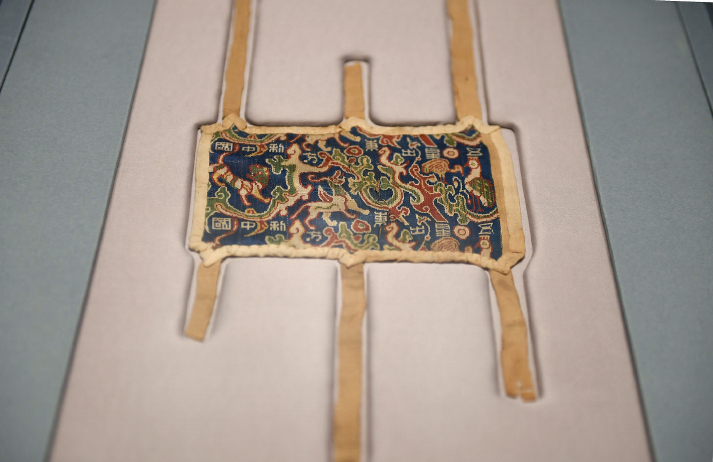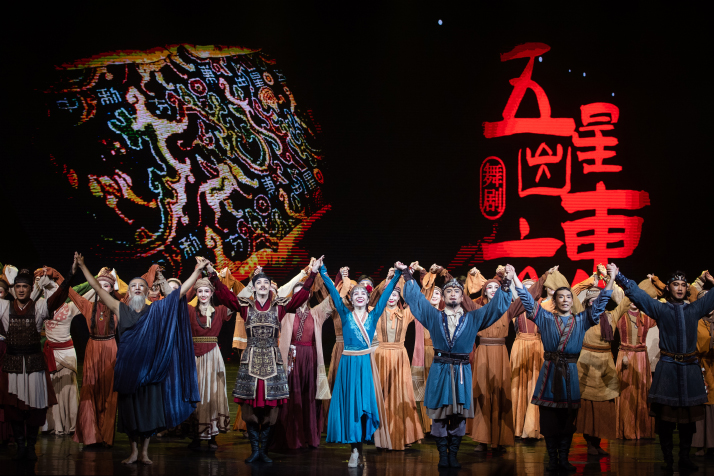| Xinjiang Today |
| A millennia-old prophecy in brocade | |
|
|
 The brocade armguard with the inscription “Five stars rise in the east, benefiting the Central Plains” on display at the Xinjiang Museum in Urumqi (VCG)
In April, the Longgang Cultural Center Grand Theater in industry hub Shenzhen in south China staged a dance drama that had a unique distinction. The co-production with artists from Beijing and Xinjiang was based on a historical artifact that carries a millennia-old prophecy about the rise of China. Dong Ning, producer of the dance drama Five Stars Rise in the East, told Shenzhen Daily, "The ancient Silk Road not only facilitated economic connections, but also created cultural bonds… This is a story about people-to-people exchanges," bringing China's cultural heritage alive for audiences to enjoy and know their history.  Dancers perform Five Stars Rise in the East in Wuhan, Hubei Province, on July 23, 2023 (XINHUA)
A sensational discovery What is the artifact and what was the prophecy? It is a brocade armguard dating back to the Han Dynasty (206 B.C.-A.D. 220) that was found by a team of Sino-Japanese archaeologists in 1995, when they excavated the ruins of an ancient kingdom in the heart of the Taklimakan Desert, the world's second largest shifting sand desert, in Xinjiang's Hetian (Hotan) Prefecture. The ancient Jingjue Kingdom was one of the 36 kingdoms of the Western Regions during the Han Dynasty, an oasis city-state that flourished as a key node on the southern route of the Silk Road but vanished by the fourth century. The armguard was found in a tomb. While cleaning the remains of the tomb's occupant, the archaeologists found a brightly colored brocade armguard on his right arm with eight Chinese characters woven in it. They read wuxing chu dongfang li zhongguo, meaning "Five stars rise in the east, benefiting the Central Plains." This is the earliest known appearance of the Chinese characters zhongguo—now meaning China. In ancient times, zhongguo, literally translated as the "middle kingdom," primarily referred to the Central Plains region along the Yellow River basin, the heartland of ancient China. The "five stars" were the five planets: Venus, Jupiter, Mercury, Mars and Saturn. Ancient Chinese astrologers believed that the simultaneous appearance of the five planets in the eastern sky was an auspicious omen for the country's military and national affairs. In the Han Dynasty, astrologers connected the rise of the dynasty with the gathering of the five stars. Consequently, the phrase "five stars rise in the east" was regarded as a popular blessing. The armguard is a testament to ethnic integration along the Silk Road, confirming the Western Regions became an official part of China during the Han Dynasty. It is regarded as one of the greatest archaeological finds of 20th-century China as it corroborates the close ties that existed between the remote Western Regions and the Central Plains rulers during the Han era. Bond of silk The armguard is made of Shu brocade, a type of silk that was extremely valuable during the Han Dynasty and was produced only in the capital Chang'an, now Xi'an, capital city of Shaanxi Province in northwest China, and the area now in Chengdu, capital of Sichuan Province in southwest China. Shu is the short form of Sichuan. It shows top-tier craftsmanship, woven with five richly colored warp threads in blue, green, red, yellow and white—making it thick and durable. These five colors are also linked to the "five stars." In addition to the characters, the beautiful pattern includes motifs of clouds, stars, peacocks, cranes and tigers. The superior material, pattern and craftsmanship indicate it was likely produced for the Han imperial court for an important occasion. How did such a valuable object appear in the distant Jingjue Kingdom? Han Emperor Wu had commissioned court diplomat and explorer Zhang Qian to explore the Western Regions and beyond to establish trade routes, which laid the groundwork for the Silk Road. After Zhang's missions to the Western Regions, close contact was established with the area and in 60 B.C., the Han imperial court established the Western Regions Frontier Command to formally govern the area, which included the Jingjue Kingdom. Silk was a primary item used for official rewards and trade. In the same tomb, archaeologists also found a brocade fragment with the characters tao nanqiang, meaning "to punish the Southern Qiang." The Southern Qiang was believed to be a group of nomadic and semi-nomadic tribes, primarily inhabiting the mountainous regions of modern Qinghai and Gansu provinces and north Sichuan. The fragment is nearly identical to the armguard in style, leading experts to believe they were cut from the same large piece of cloth. Therefore, the full inscription on the original fabric may have been "Five stars rise in the east, benefiting the Central Plains, punishing the Southern Qiang." Based on this, experts conclude that the brocade armguard was likely a good luck charm specially made for a smooth victory in the campaign against the Southern Qiang. It was given as a reward to a nobleman of the Jingjue Kingdom who had assisted the Han forces. The nobleman regarded it as a symbol of honor and it was buried with him. This also indicates that the societies of the Western Regions, including Jingjue, identified with the Han Dynasty.  Desert poplars at the Niya Ruins in Hetian (Hotan) Prefecture where the brocade armguard was discovered (VCG)
The artifact's new story Today, the armguard is a strictly protected cultural relic that cannot be taken out of the country even as part of Chinese exhibitions abroad. It featured in China Before China, a 2022 special exhibition at the Palace Museum, in Beijing, telling people stories of the past. The Palace Museum, also known as the Forbidden City, housed China's royal family from the 15th century to the early 20th century. It has also inspired the dance drama Five Stars Rise in the East, which tells the story of comradeship and collaboration. A Han general named Feng is sent to the western border where he befriends Jiante, son of the leader of the Northern State, and Chunjun, daughter of the leader of the Jingjue Kingdom. At first the trio are wary of one another and there is conflict but finally, they unite to rebuild the city wall. The press release says, "The dance piece revitalizes a precious artifact, and, through its referencing 'five stars in the east', reminds us never to forget our bond, which 'holds us together like pomegranate seeds,' an ideal that consolidates the sense of community for the Chinese nation." After its premiere in Beijing in 2021, Five Stars Rise in the East toured the country and won the Wenhua Award, China's highest governmental award for the performing arts. Through dance, the drama brings the story behind the national treasure to life, enabling more people to learn about a special piece of history of cultural exchange and integration. Comments to maxiaowen@cicgamericas.com |
|
||||||||||||||||||||||||||||
|